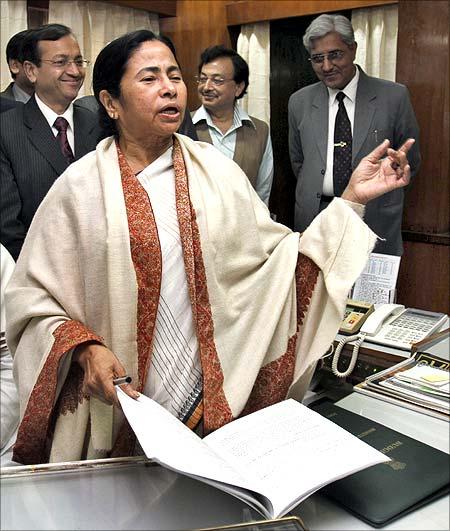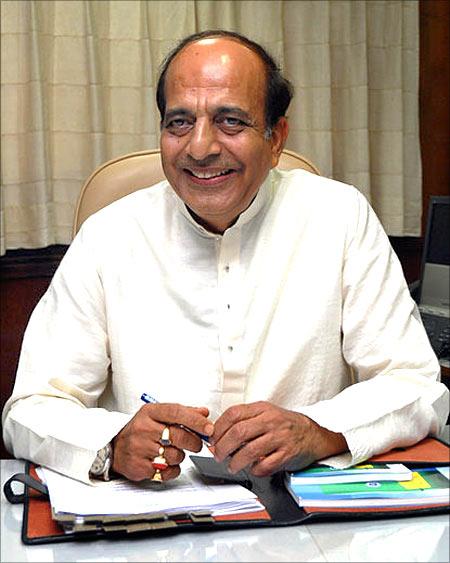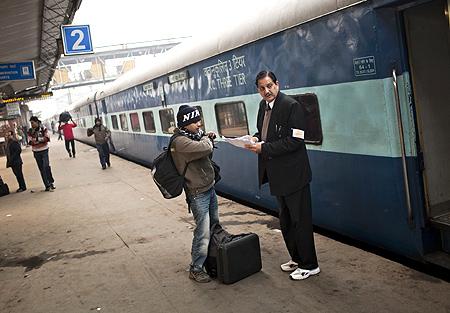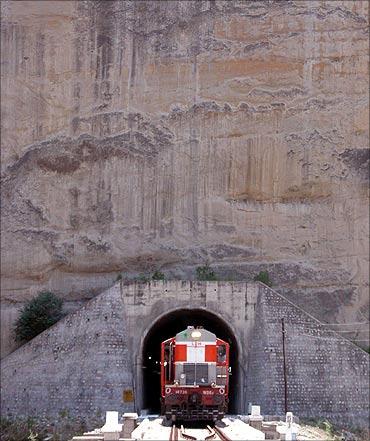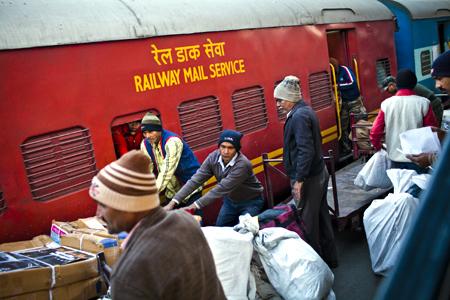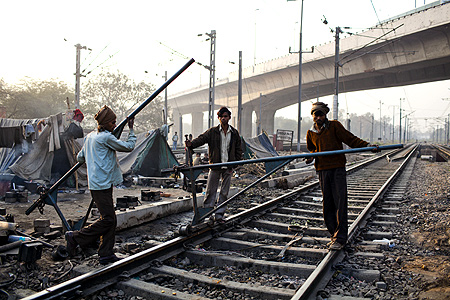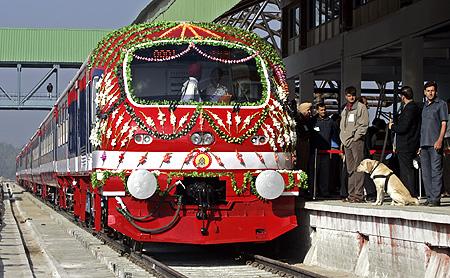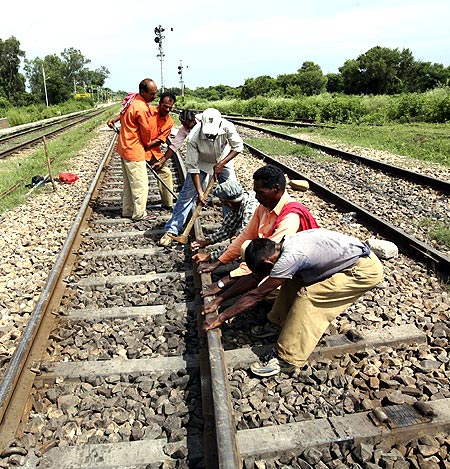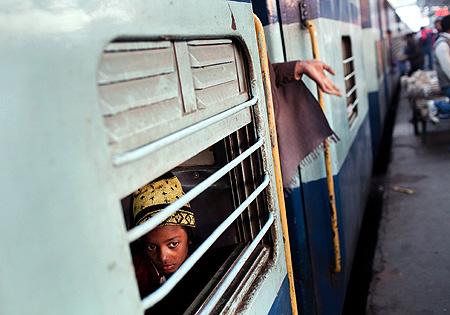 | « Back to article | Print this article |
How Mamata ruined the profitable Railways
Three years is all it took for Mamata Banerjee to bring the railways down. An effort is on to change the fortunes of the country's largest transport network. But it's a long journey ahead
It's been almost a month since Mamata Banerjee stormed out of the United Progressive Alliance. The railway ministry, which was under Banerjee's Trinamool Congress since 2009, has after her departure taken some corrective steps.
Imposition of service tax, which had the effect of raising fares across the board, came in quick time. C P Joshi, the new railway minister, has announced the formation of the Rail Tariff Authority, a step which will take fare and tariff fixation out of all political influence.
The newfound reformist zeal of the Manmohan Singh-led government will in all likelihood spread to the railways as well.
Click NEXT to read more...
How Mamata ruined the profitable Railways
For many years now, the railways have not raised fares in a bid to protect the interests of the common man; instead, the railways have raised freight tariff regularly to cover their mounting expenses.
As a result, while train fares in India are abnormally low, freight rates are amongst the highest in the world. This has stoked inflation (so much for protecting the aam admi!) and promoted inefficiency.
Companies and traders now found it economical to transport their goods over short and medium distances by road than by rail.
Banerjee took over as the railway minister from Lalu Prasad after the 2009 elections. Prasad had been routed in Bihar, while Banerjee had emerged as the largest party in UPA after the Congress.
Click NEXT to read more...
How Mamata ruined the profitable Railways
As reward, she got this plum portfolio. Prasad had been appointed railway minister in 2004.
Facing a lot of flak over his inept administration of Bihar, which cost him the chief minister's post, he had a point to prove. The railways, at that time, were losing money.
He responded by effecting a massive increase in axle loading. Though Prasad decreased passenger fares by Rs 1, the powerful Railway Board forced him to
(1) subsume the levy for the Rs 17,000-crore Special Railway Safety Fund into passenger fare,
(2) increase the cash flows by converting many passenger and mails into superfast express trains,
(3) increase Tatkal service levies,
(4) sell more higher-priced tickets by upgrading 2nd-class sleeper passengers to empty air-conditioned coaches, and
(5) introduce the rail development surcharge of two per cent on freight as well as fares.
How Mamata ruined the profitable Railways
When he left, the railways had turned into surplus; the net revenue after dividend stood at Rs 4,456 crore for 2008-09, his last year as railway minister.
In 2011-12, after three years under the Trinamool Congress (Banerjee was followed by Dinesh Trivedi after she became the chief minister of West Bengal in May last year; she replaced Trivedi unceremoniously with Mukul Roy in March this year after he dared to raise fares from 8 to 22 per cent and presented a reformist budget. Roy, of course, promptly rolled back the increases), this number was down to a third, Rs 1,492 crore.
This money is meant for the capital and safety funds of the railways. The efficiency of the railways is measured by the operating ratio (working expenses as a portion of traffic receipts).
During Prasad's tenure, it had improved to 75.9 per cent in 2007-08, before falling to 90.5 per cent in 2008-09.
For last year, it stood at 95 per cent. The annual losses in passenger and parcel services are projected to rise to Rs 23,000 crore by the end of 2012-13 from around Rs 19,000 crore when Banerjee took over.
Click NEXT to read more...
How Mamata ruined the profitable Railways
Banerjee's real target, insiders say, was always the chief minister's office in West Bengal. That cannot be said with certainty.
But it's a fact that she used her railway budgets to shower projects on her state. (She had, in 1997, infamously hurled her shawl at Ram Vilas Paswan, the then finance minister, for ignoring West Bengal.)
In July 2009, Banerjee awarded a coach factory and a 1,000 MW power plant to the state. Her other achievement for the year was the launch of long-distance Duronto express trains that ran nonstop between their destinations.
The next year, she lavished a water bottling plant at Farrakha, axle factory in New Jalpaiguri, wagon factories at Bardhaman and Haldia, and a refrigerated container unit at Budge Budge.
The railways, she said, could also set up a coach factory at Singur, where Tata Motors planned first to produce the Nano, provided 400 acres are used to resettle farmers.
Click NEXT to read more....
How Mamata ruined the profitable Railways
She had been ticked off earlier by Pranab Mukherjee, then finance minister, for favouring West Bengal with projects even though her finances were not in order; so Banerjee made peace overtures by proposing a coach factory at Rae Bareli in Uttar Pradesh, the constituency of UPA Chairperson Sonia Gandhi.
In 2011-12, Banerjee announced 176 trains and among them 29 (around 16 per cent) had either West Bengal as origin or the terminal destination. Meanwhile, contracts for the locomotive, coach and component factories at Madhepura (Bihar), Marhowra (Bihar), Kanchrapara (West Bengal) and Dankuni (West Bengal), announced during Prasad's tenure, are yet to be awarded!
It was left for Trivedi to disclose the rot in his railway budget speech in March this year. As many as 487 projects (new lines, gauge conversion, doubling of track and electrification) worth Rs 100,000 crore "cannot be completed in a time-bound manner" because of a "grossly inadequate level of budgetary support", he said.
Click NEXT to read more...
How Mamata ruined the profitable Railways
The national projects in Kashmir and the Northeast, which entail an investment of Rs 4,000 crore, "may get delayed for want of adequate funding".
"Given the serious constraints of funds even to meet the day-to-day operational expenditure, I have a Himalayan task of running the Indian Railways safely," he added. Trivedi admitted that public-private partnerships, which were meant to help the railways bankroll several projects, have not met with the desired results.
Trivedi, therefore, raised fares, after having revised freight rates by a steep margin earlier in the month.
To tide over the funds crunch, Trivedi announced the setting up of three special-purpose vehicles which could raise funds on their own balance sheet: Rail-Road Grade Separation Corporation of India (to eliminate all level crossings), Indian Railway Station Development Corporation (to redevelop 100 stations in the next five years) and Logistics Corporation (to develop and manage sheds and multimodal logistics parks).
Click NEXT to read more...
How Mamata ruined the profitable Railways
He said he was also considering segregating the fuel component in the cost of passenger services, which would be raised or lowered with every change in fuel cost.
Trivedi had also promised that he will constitute a body of experts to examine the feasibility of an independent Railway Tariff regulatory Authority.
But all this proved too much for Banerjee - she replaced him with Roy in double-quick time. (While Banerjee was incensed at Trivedi's insensitivity towards the common man, she has in West Bengal not flinched from raising milk prices, power tariffs and bus fares.) Roy undid whatever his predecessor had proposed.
Roy, in any case, was seen more in Kolkata, in the company of his mercurial leader, than at Rail Bhawan, the headquarters of the railway ministry in New Delhi.
Click NEXT to read more...
How Mamata ruined the profitable Railways
The task ahead is onerous. There is an urgent need for track renewal. In the last 65 years since Independence, the railway network has increased from 52,000 km to 64,000 km.
A former member of the Railway Board reckons the network could have been increased by 6,000 km during the 10th and 11th Five year plans (2002-07 and 2007-12) at a cost of Rs 48,000 crore, had the railways spent the Plan expenditure of Rs 284,000 crore (of which the gross budgetary support from the government, he says, would have been 40 per cent, or Rs 113,000 crore) wisely.
Wear and tear on existing lines could soon begin to show.
"The pushing in of more and more passenger trains on the same network as freight makes the network choke as the railways struggle to run freight services which brings in the money," says Amrit Pandurangi, senior director at Deloitte.
Click NEXT to read more...
How Mamata ruined the profitable Railways
The golden quadrilateral of trunk routes (Delhi-Mumbai-Chennai-Kolkata), which constitutes 20 per cent of the route length, accounts for 55 to 60 per cent of the total railway traffic (passenger plus freight).
The Dedicated Freight Corridor, the biggest public-private partnership that the railways like to talk about, was seen as the way out.
The plan was to put all freight traffic on this corridor and decongest the existing network for passenger trains.
However, six years have passed since Dedicated Freight Corridor Corporation was set up in 2006-07 and no contracts have been awarded to private players for the construction of the corridor.
Click NEXT to read more...
How Mamata ruined the profitable Railways
Freight is where the real money lies. When a line is used only for freight, the operating ratio can be as good as 75 per cent, and if it runs only passenger trains the ratio can deteriorate to 190 to 200 per cent (100 per cent is the breakeven point).
The railways are the leader in transportation of bulk goods, with a market share of almost 70 per cent, yet their share is very small, around 5 per cent, in finished products.
The reason is that the railways made a conscious decision in the 1980s to carry only trainloads rather than wagon-loads.
Since then, the railways have never adapted to cater to the huge demand for transportation of white goods etc.
Click NEXT to read more...
How Mamata ruined the profitable Railways
The container business in railways was conceptualised to cater to such piecemeal traffic; but it's struggling - its annual contribution to the railways' freight earnings is just around 4 per cent.
And, of course, there is a need to rationalise freight tariff, but that cannot happen unless passenger fares are raised.
In a recent article in Business Standard, R Sivadasan, former financial commissioner of the railways, had written: "The spiel of 'not increasing passenger fares' has provided the railways a handy cover for not bothering about the quality of passenger services."
Who will bite the bullet?
